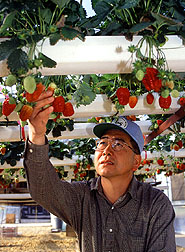This page has been archived and is being provided for reference purposes only. The page is no longer being updated, and therefore, links on the page may be invalid.
Hydroponics an Option for Growing Strawberries Without Methyl BromideBy Doris StanleyNovember 16, 1998 To grow strawberries without methyl bromide, farmers can go back to the ancient practice of hydroponics. Agricultural Research Service scientists found that their hydroponic strawberry plants are as productive as plants grown in soil fumigated with methyl bromide. Strawberry growers worldwide fumigate soil with methyl bromide before planting to control soilborne insects, diseases and weeds. The chemical is essential to get high yield and high quality fruit. But it’s been named an ozone depletor; production and use will be phased out over the next few years. So growers need an effective alternative. Otherwise, annual production of field-grown strawberries will be cut dramatically in California and Florida, the major producing states. Hydroponics is an option, according to the scientists at the ARS Appalachian Fruit Research Station in Kearneysville, W.Va. ARS is USDA’s chief research agency. From hydroponically grown plants, Kearneysville horticulturist Fumiomi Takeda harvested ripe fruit twice a week from December to May, the period when shipments of California strawberries slow down. Fruit quality and taste were excellent. He controlled the few foliage pests with natural agents. Initial setup costs for hydroponic farming are high. But growers may recoup them by producing a higher value product, increasing yields and spending less money on pests and diseases. Environmental factors don’t affect greenhouse crops, and hydroponically grown berries reduce labor costs. Further study is needed on strawberry varieties other than the two California ones used in the research. This story is featured in the November Agricultural Research magazine. It also is available on the World Wide Web at: /is/AR/archive/nov98/hydro1198.htm Scientific contact: Fumiomi Takeda, Appalachian Fruit Research Station, USDA-ARS, Kearneysville, WV 25430-9425; phone (304) 725-3451, X-212, fax (304) 728-2340, email ftakeda@afrs.ars.usda.gov
|

